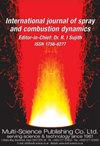Distributed heat release effects on entropy generation by premixed, laminar flames
IF 2.1
4区 工程技术
Q3 ENGINEERING, MECHANICAL
International Journal of Spray and Combustion Dynamics
Pub Date : 2023-05-10
DOI:10.1177/17568277231172887
引用次数: 1
Abstract
This article studies the generation of entropy disturbances by laminar premixed flames. The total entropy generation equals the integrated ratio of the local heat release rate and the local temperature, namely, ∫ ( q ˙ / T ) d V . Due to this path dependency, evaluating this integral requires an understanding of how the heat release is distributed in the temperature space. Several studies evaluate the local entropy generation as ( ∫ q ˙ d V ) / T b , where T b refers to the burned gas temperature, implicitly assuming all the heat release occurs at T b . Such an approximation is motivated by the high activation energy nature of combustion chemistry. This work evaluates this assumption by comparing it to results from one-dimensional premixed flame calculations for hydrogen, methane, and propane-air flames over a range of pressures, equivalence ratios, and preheat temperatures, quantified via the ratio κ . We show that this assumption is quite reasonable for methane and propane-air flames (with errors ranging from 5% to 25%) but deviates significantly from the exact results for hydrogen flames (where errors can be as high as 50%). In general, the peak heat release moves to lower temperatures as preheat temperature is increased. Noting that the temperature sensitivity of heat release is directly related to the activation energy, we use Law's approach to extract global activation energies and show that the deviations of κ from unity can be approximately correlated with β e f f . Finally, we show that significant improvements in entropy generation calculations can be obtained by estimating ∫ ( q ˙ / T ) d V using ( ∫ q ˙ d V ) / T p e a k , where T p e a k is the temperature at which the reaction rate peaks. This estimation leads to predictions of ∼5% within the exact value for the hydrocarbon cases but can still be in significant error for hydrogen at certain conditions.分布热释放对预混层流火焰熵产生的影响
本文研究了层流预混火焰产生熵扰动的问题。总熵产生等于局部热释放率和局部温度的积分比,即¦Β(q*/T)dV。由于这种路径依赖性,评估该积分需要了解热量释放在温度空间中的分布情况。一些研究将局部熵产生评估为(Şq*d V)/Tb,其中Tb是指燃烧气体的温度,隐含地假设所有的热释放都发生在Tb。这种近似是由燃烧化学的高活化能性质引起的。这项工作通过将这一假设与氢气、甲烷和丙烷空气火焰在一定压力、当量比和预热温度范围内的一维预混火焰计算结果进行比较来评估这一假设,并通过比率κ进行量化。我们表明,这一假设对于甲烷和丙烷空气火焰是非常合理的(误差范围从5%到25%),但与氢气火焰的确切结果有很大偏差(误差可能高达50%)。通常,随着预热温度的升高,峰值热释放移动到较低的温度。注意到热释放的温度敏感性与活化能直接相关,我们使用Law的方法提取全局活化能,并表明κ与单位的偏差可以与βe f近似相关。最后,我们证明了熵生成计算的显著改进可以通过使用(ξq*d V)/T p e a k来估计ξ(q*/T)d V来获得,其中T p e a k是反应速率达到峰值的温度。这一估计导致碳氢化合物情况下预测的准确值为~5%,但在某些条件下,氢气的预测仍可能存在显著误差。
本文章由计算机程序翻译,如有差异,请以英文原文为准。
求助全文
约1分钟内获得全文
求助全文
来源期刊

International Journal of Spray and Combustion Dynamics
THERMODYNAMICS-ENGINEERING, MECHANICAL
CiteScore
2.20
自引率
12.50%
发文量
21
审稿时长
>12 weeks
期刊介绍:
International Journal of Spray and Combustion Dynamics is a peer-reviewed open access journal on fundamental and applied research in combustion and spray dynamics. Fundamental topics include advances in understanding unsteady combustion, combustion instability and noise, flame-acoustic interaction and its active and passive control, duct acoustics...
 求助内容:
求助内容: 应助结果提醒方式:
应助结果提醒方式:


